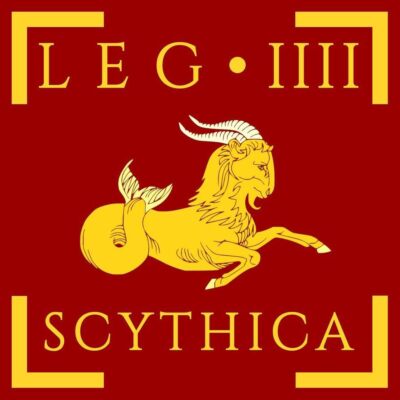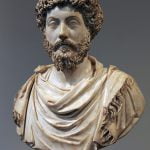Chapters
Legio IV Scythica or actually IIII Scythica, because this is how its name was originally spelt, the beginnings of its existence are ordered in the times of the 2nd triumvirate. It was founded by one of the triumvirs – Mark Antony – probably a few years after 42 BCE. Neither the first historical seat of the legion nor its area of operation is known. There are, however, two possible possibilities. The first places “fourth” in Syria which would mean Scythica participated in Marcus Antony’s ill-fated campaign against the Party. The second, on the other hand, closer to the origin of the legion’s nickname, indicates the area of the lower Danube as the place of combat baptism. According to this hypothesis, the unit, together with the Fifth Legion, was to fight the Scythian tribes venturing into the vicinity of the Roman city of Olibia. It is possible that Scythica was named so and not because of a significant victory (though it is impossible to establish a date) over one of these tribes. It is also possible that this victory was achieved much later than at the beginning of the legion’s history.
It is an indisputable fact that the nickname of an individual literally means “the legion from Scythia”, also interpreted as a reflection of the extraordinary bravery and courage of his soldiers – such as in the case of the famous Scythians. The sign of the legion was the image of the zodiac Capricorn.
Service on the Danube
With Octavian Augustus after the battle of Actium, we have some more certain information on the “fourth”. Interestingly, it is during these reigns that the legion’s nickname is officially accepted. The unit certainly operates at that time in Moesia, on the lower Danube, where in the years 29 – 27 BCE fights heavy fights. Its commander, Marcus Licinius Crassus (grandson of the triumvir – the legion’s founder), covers himself with the glory of a brave warrior, defeating the enemy leader face to face. The sources as the most probable location of castra Scythici give the vicinity of Viminacium (Kostolac in eastern Serbia).
Between 6 and 9 CE, IIII Scythica takes part in the campaign of the future emperor Tiberius against the tribes of Illyria and Pannonia on the central Danube.
The combat actions, however, are not the only ones in this period of the legion’s history. Rock inscriptions from those times clearly speak of the great role of the “fourth” in the construction of roads and other engineering works in the Danube region of the Empire. It is, as it is easy to guess, the result of the conquest and the need to develop new areas. At that time, there was also a strong collaboration between IIII Scythica and V Macedonica, whose forces were usually joined in a joint section.
At this point, a young man who has passed through the cadres of the “Scythian” must not be overlooked. Titus Flavius Vespasianus, commonly known as Emperor Vespasian, is included in the list of great personalities associated with the legion.
East dislocation
Nero’s reign marks a turning point in the history of Scythica. The legion is moved to the east and from then on, it will never again operate in Europe. The first major event in the unit’s eastern history is participation in a retaliatory campaign against the Parthians. Its story begins when Gnaeus Domitius Corbulo conducts a military operation in the Kingdom of Armenia to establish a king favourable to Rome. Despite the successes of three legions (III Gallica, VI Ferrata and X Fretensis) and the capture of two more Armenian capitals – Artaxta (58 CE) and Tigranocerta (59 CE) – the newly enthroned King Tigranes (great-grandson of the Jewish king, Herod the Great) has to step down quite quickly. Parthians, concerned about the growing influence of Rome, bring their man to power – Tiridates, the own brother of King Vologases I. At this moment IIII Scythica and XII Fulminata under the command of the governor of Cappadocia Lucius Caesennius Paetus is sent to Armenia to restore Roman order. Unfortunately, in the winter of 62/63, the Parthians forced the Romans to surrender to Rhanedia. Unfortunately, this defeat will cast a serious shadow on the combat fame of the legion to such an extent that the “fourth” will not take part in the next Corbulo campaign, in which the Romans will, however, put their own way and for the second time Tigranes will receive the royal crown from the Emperor’s hands.
From 66 CE legio IIII Scythica was stationed in the city of Zeugma. It was quite an important place in terms of future conflicts with the Parthians because there was an important crossing over the Euphrates on the border with the Party. The city remained the seat of the legion for almost two centuries, as evidenced by the highly Romanized culture of the area and numerous archaeological traces.
During the civil war of 69 CE, which resulted from Nero’s suicide, the “Scythian” took the side of his former officer – Vespasian. Despite this, he did not take part in any action because the higher Roman command completely depreciated his combat value. The defeat of the Armenian expedition was also remembered and not later than three years earlier (66 CE) the combined forces of Scythites, Fulminata and Ferrats were defeated during the trial of the suppression of the Jewish revolt, which explains the decision of the command.
Nevertheless, in 70 CE the “fourth” was used to pacify the riots in Antioch.
When it comes to curiosities from this period, it is worth mentioning the most famous Scythica soldier, whose name was Tiberius Julius Celsus Polemaeanus. The famous library in Ephesus was dedicated to him. The participation of the “fourth” legionaries in the construction of the canal in Seleucia is also noteworthy.
Fighting on the frontier
Due to the very turbulent area where the legion was stationed, its history was still very turbulent. In the years 132-136 CE sub-units of IIII fought against the Jewish insurgents led by Simon ben Kosiba. It was also not without further conflicts with the Parthians, such as, for example, in the years 114-117 CE during the reign of Trajan, or between 161 and 166 under Lucius Verus, which ended with the plunder of the Parthian capital. Year 181 CE brought the change of the commander to another famous figure – the future emperor Lucius Septimius Severus. He commanded Scythica until 183, but as future events show, the sentiment towards his own unit probably remained because as emperor he took it on his first campaign against his hated neighbour in 194 CE. In the following years, from 195 to 196 CE the supreme power in the legion was exercised by Gaius Julius Avitus Alexianus, the emperor’s father-in-law and the grandfather of two future emperors (Elagabalus and Alexander Severus). 197-198 CE is Severus’ second war with the Parthians, in which Scythica could not be absent. The legionaries of the “fourth” once again rob Ctesiphon – the capital of the Party. This time around, the Parthian empire will not recover from another such blow. However, one generation is enough to be replaced by the powerful kingdom of Persian Sassanids.
It is likely that IIII Scythic participated in the Eastern campaign of Emperor Caracalla, who was murdered in Harran in 217 CE. After this event, the legion went to its permanent station – Zeugma in Commagene. In 219 CE the commander of the “fourth” Gellius Maximus rebelled against the Emperor of Elagabalia but was quickly removed. Although the open insubordination did not turn out to be dangerous and the crisis in the unit was averted after this incident, the legion disappears from historical sources. However, the further existence of the unit is highly probable because it is mentioned in the document “Notitia Dignitatum” from the beginning of the 5th century CE. IIII is mentioned as part of the Roman forces in Syria but is located elsewhere than before. The dislocation of castra Scythici (some sources mention the city of Sura on the Euphrates) is attributed to Diocletian.
Unclear end
After the rebellion in IIII Scythica, nothing really is clear about the individual’s history. Assuming the continued existence of the legion, its participation in the campaigns of successive emperors against the Persians, ending very differently, by the way – from complete defeats to significant successes, should be considered certain. It is impossible to establish any, even approximate, date of dissolution or annihilation of this tactical relationship. We do not even know if it was wiped out in battle or disbanded administratively. This information is probably lost in the chaos of the last decades before the fall of the Roman Empire. We can only assume that the legion survived until the 4th century CE when his story ends unexplained.







